Sustainable Marketing in the Fashion Industry: Adidas and H&M Analysis
VerifiedAdded on 2022/11/09
|12
|2593
|342
Report
AI Summary
This report provides a critical analysis of sustainable marketing practices, focusing on Adidas and H&M within the context of the fashion industry's environmental impact. It begins by introducing the concept of sustainable marketing and the growing concerns surrounding resource usage and waste in the industry, particularly within the fast-fashion sector. The report then delves into the specific initiatives of Adidas and H&M, examining their approaches to resource management and circular economy models. Adidas's efforts, such as the Futercraft Loop, are discussed in terms of narrowing and closing resource loops, while H&M's broader integration of sustainability across its supply chain, including partnerships with organizations like the Ellen MacArthur Foundation, is highlighted. The report explores the fundamental approaches of a circular economy, including narrowing, slowing, and closing resource loops, and assesses how Adidas and H&M have incorporated these strategies. Value dimensions, including value propositions, creation, delivery, and capture, are analyzed for both brands, demonstrating how they create value through sustainable practices. The conclusion summarizes the progress and challenges of both companies in achieving circularity and addressing environmental concerns within the fashion industry. References include sources like Dhakatribune.com, Circulareconomy.europa.eu, and About.hm.com.
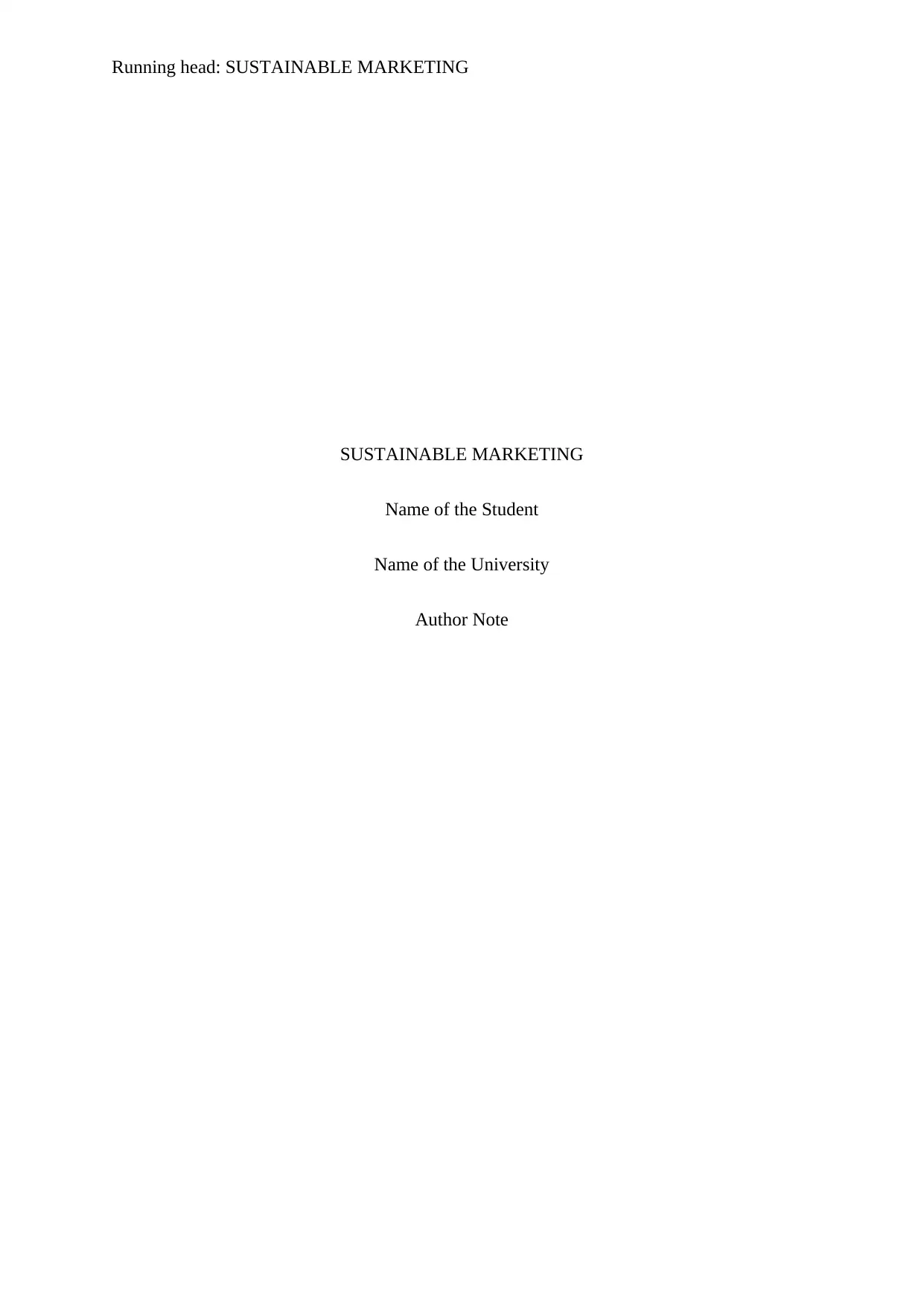
Running head: SUSTAINABLE MARKETING
SUSTAINABLE MARKETING
Name of the Student
Name of the University
Author Note
SUSTAINABLE MARKETING
Name of the Student
Name of the University
Author Note
Paraphrase This Document
Need a fresh take? Get an instant paraphrase of this document with our AI Paraphraser
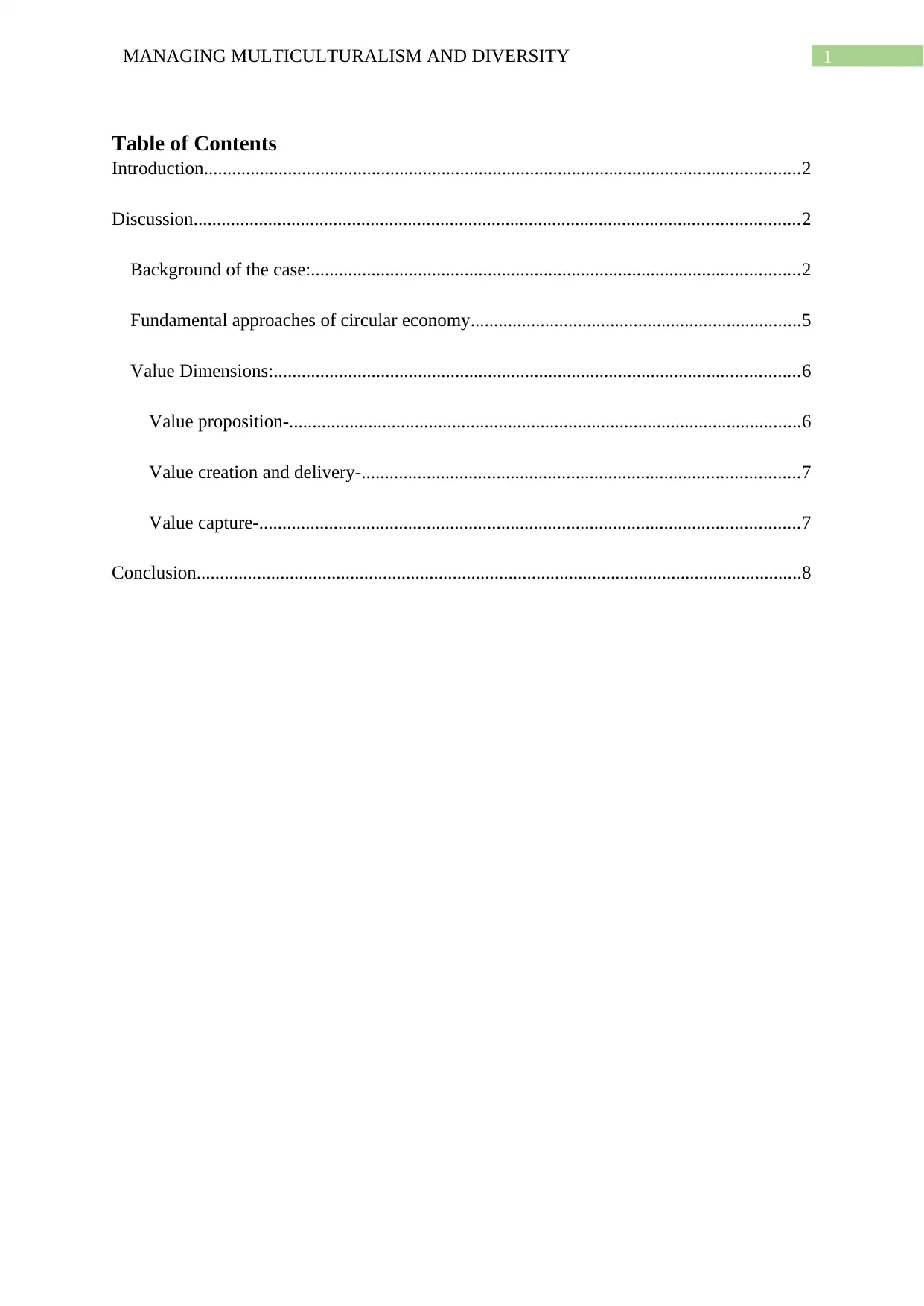
1MANAGING MULTICULTURALISM AND DIVERSITY
Table of Contents
Introduction................................................................................................................................2
Discussion..................................................................................................................................2
Background of the case:.........................................................................................................2
Fundamental approaches of circular economy.......................................................................5
Value Dimensions:.................................................................................................................6
Value proposition-..............................................................................................................6
Value creation and delivery-..............................................................................................7
Value capture-....................................................................................................................7
Conclusion..................................................................................................................................8
Table of Contents
Introduction................................................................................................................................2
Discussion..................................................................................................................................2
Background of the case:.........................................................................................................2
Fundamental approaches of circular economy.......................................................................5
Value Dimensions:.................................................................................................................6
Value proposition-..............................................................................................................6
Value creation and delivery-..............................................................................................7
Value capture-....................................................................................................................7
Conclusion..................................................................................................................................8
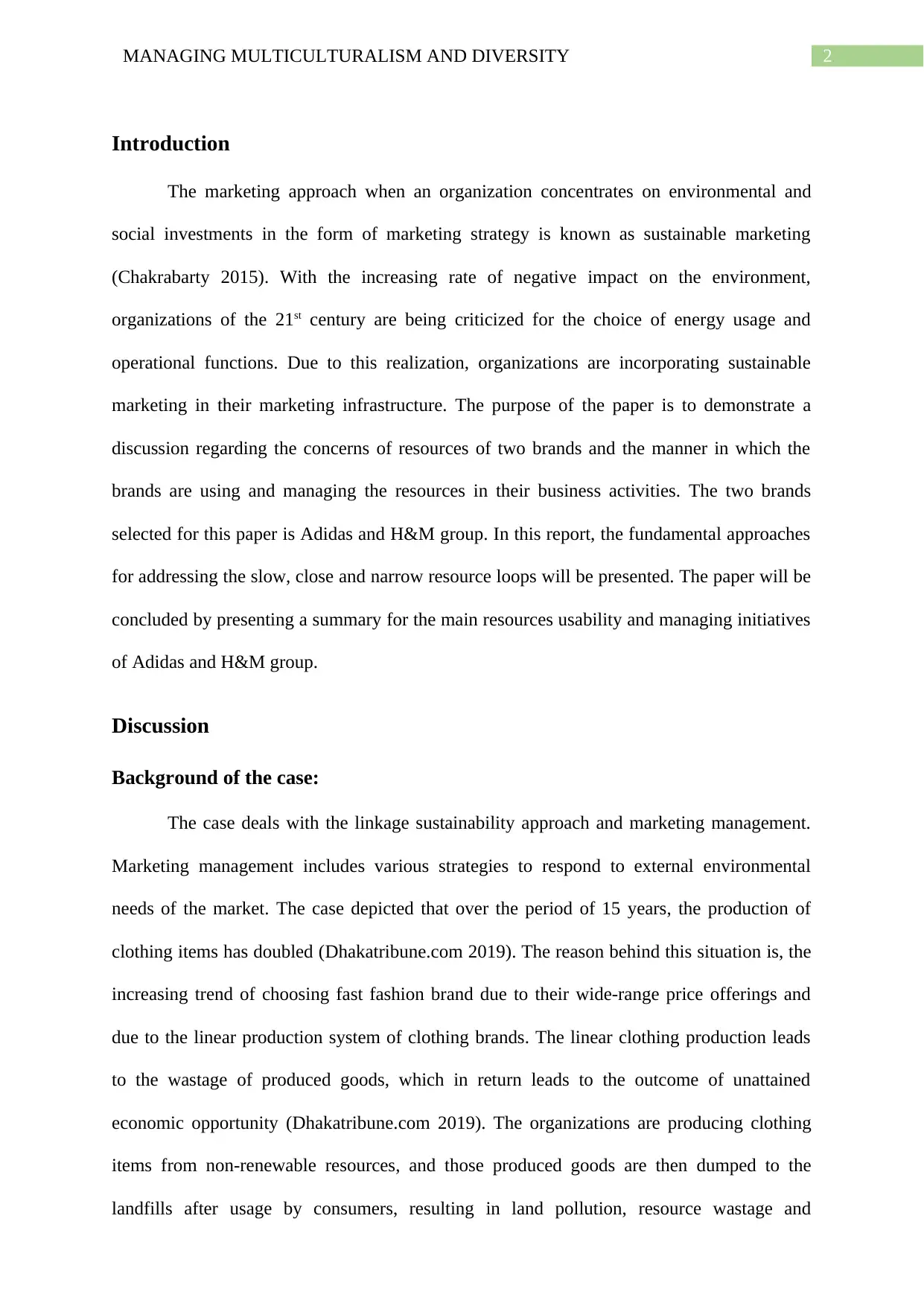
2MANAGING MULTICULTURALISM AND DIVERSITY
Introduction
The marketing approach when an organization concentrates on environmental and
social investments in the form of marketing strategy is known as sustainable marketing
(Chakrabarty 2015). With the increasing rate of negative impact on the environment,
organizations of the 21st century are being criticized for the choice of energy usage and
operational functions. Due to this realization, organizations are incorporating sustainable
marketing in their marketing infrastructure. The purpose of the paper is to demonstrate a
discussion regarding the concerns of resources of two brands and the manner in which the
brands are using and managing the resources in their business activities. The two brands
selected for this paper is Adidas and H&M group. In this report, the fundamental approaches
for addressing the slow, close and narrow resource loops will be presented. The paper will be
concluded by presenting a summary for the main resources usability and managing initiatives
of Adidas and H&M group.
Discussion
Background of the case:
The case deals with the linkage sustainability approach and marketing management.
Marketing management includes various strategies to respond to external environmental
needs of the market. The case depicted that over the period of 15 years, the production of
clothing items has doubled (Dhakatribune.com 2019). The reason behind this situation is, the
increasing trend of choosing fast fashion brand due to their wide-range price offerings and
due to the linear production system of clothing brands. The linear clothing production leads
to the wastage of produced goods, which in return leads to the outcome of unattained
economic opportunity (Dhakatribune.com 2019). The organizations are producing clothing
items from non-renewable resources, and those produced goods are then dumped to the
landfills after usage by consumers, resulting in land pollution, resource wastage and
Introduction
The marketing approach when an organization concentrates on environmental and
social investments in the form of marketing strategy is known as sustainable marketing
(Chakrabarty 2015). With the increasing rate of negative impact on the environment,
organizations of the 21st century are being criticized for the choice of energy usage and
operational functions. Due to this realization, organizations are incorporating sustainable
marketing in their marketing infrastructure. The purpose of the paper is to demonstrate a
discussion regarding the concerns of resources of two brands and the manner in which the
brands are using and managing the resources in their business activities. The two brands
selected for this paper is Adidas and H&M group. In this report, the fundamental approaches
for addressing the slow, close and narrow resource loops will be presented. The paper will be
concluded by presenting a summary for the main resources usability and managing initiatives
of Adidas and H&M group.
Discussion
Background of the case:
The case deals with the linkage sustainability approach and marketing management.
Marketing management includes various strategies to respond to external environmental
needs of the market. The case depicted that over the period of 15 years, the production of
clothing items has doubled (Dhakatribune.com 2019). The reason behind this situation is, the
increasing trend of choosing fast fashion brand due to their wide-range price offerings and
due to the linear production system of clothing brands. The linear clothing production leads
to the wastage of produced goods, which in return leads to the outcome of unattained
economic opportunity (Dhakatribune.com 2019). The organizations are producing clothing
items from non-renewable resources, and those produced goods are then dumped to the
landfills after usage by consumers, resulting in land pollution, resource wastage and
⊘ This is a preview!⊘
Do you want full access?
Subscribe today to unlock all pages.

Trusted by 1+ million students worldwide
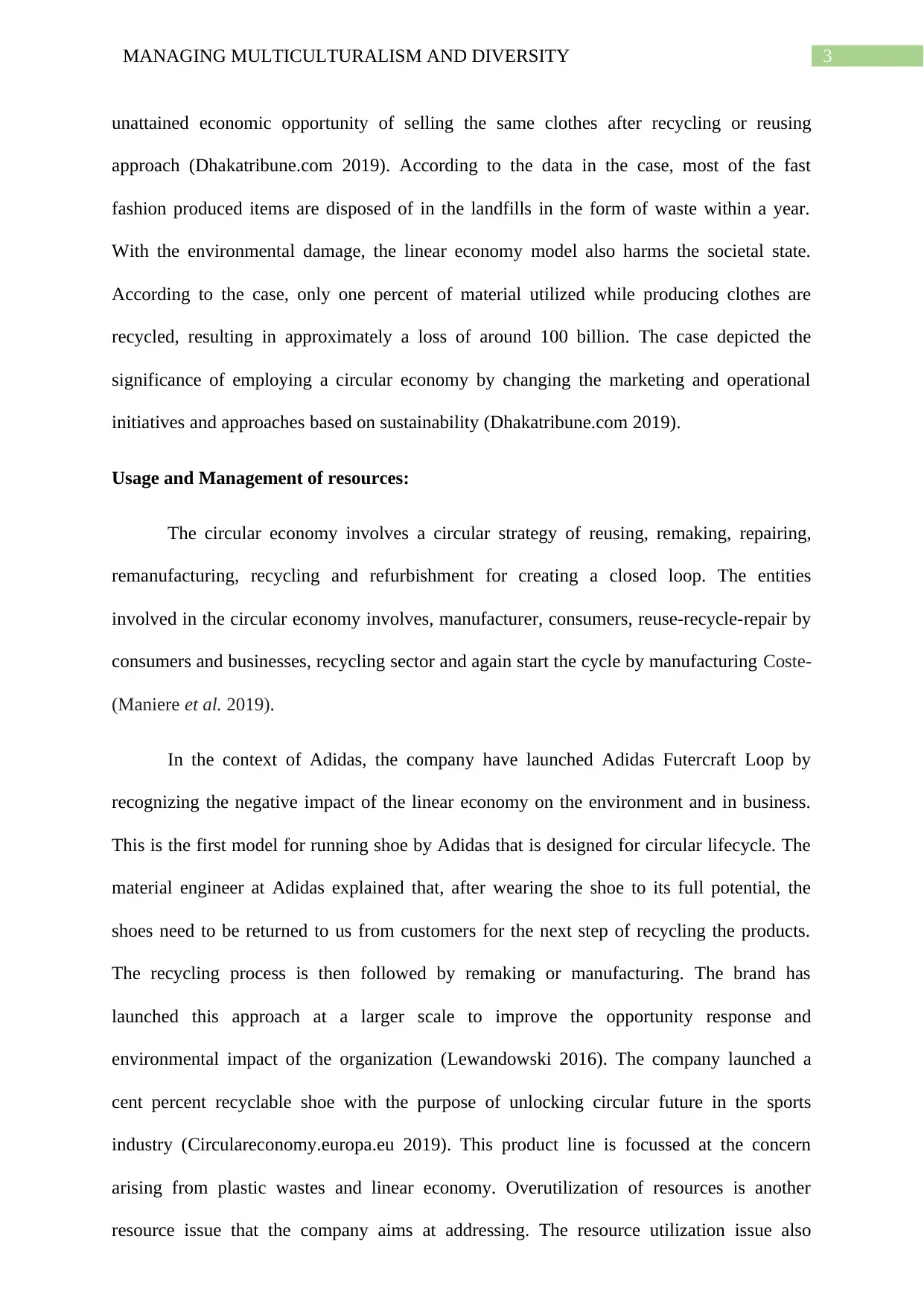
3MANAGING MULTICULTURALISM AND DIVERSITY
unattained economic opportunity of selling the same clothes after recycling or reusing
approach (Dhakatribune.com 2019). According to the data in the case, most of the fast
fashion produced items are disposed of in the landfills in the form of waste within a year.
With the environmental damage, the linear economy model also harms the societal state.
According to the case, only one percent of material utilized while producing clothes are
recycled, resulting in approximately a loss of around 100 billion. The case depicted the
significance of employing a circular economy by changing the marketing and operational
initiatives and approaches based on sustainability (Dhakatribune.com 2019).
Usage and Management of resources:
The circular economy involves a circular strategy of reusing, remaking, repairing,
remanufacturing, recycling and refurbishment for creating a closed loop. The entities
involved in the circular economy involves, manufacturer, consumers, reuse-recycle-repair by
consumers and businesses, recycling sector and again start the cycle by manufacturing Coste-
(Maniere et al. 2019).
In the context of Adidas, the company have launched Adidas Futercraft Loop by
recognizing the negative impact of the linear economy on the environment and in business.
This is the first model for running shoe by Adidas that is designed for circular lifecycle. The
material engineer at Adidas explained that, after wearing the shoe to its full potential, the
shoes need to be returned to us from customers for the next step of recycling the products.
The recycling process is then followed by remaking or manufacturing. The brand has
launched this approach at a larger scale to improve the opportunity response and
environmental impact of the organization (Lewandowski 2016). The company launched a
cent percent recyclable shoe with the purpose of unlocking circular future in the sports
industry (Circulareconomy.europa.eu 2019). This product line is focussed at the concern
arising from plastic wastes and linear economy. Overutilization of resources is another
resource issue that the company aims at addressing. The resource utilization issue also
unattained economic opportunity of selling the same clothes after recycling or reusing
approach (Dhakatribune.com 2019). According to the data in the case, most of the fast
fashion produced items are disposed of in the landfills in the form of waste within a year.
With the environmental damage, the linear economy model also harms the societal state.
According to the case, only one percent of material utilized while producing clothes are
recycled, resulting in approximately a loss of around 100 billion. The case depicted the
significance of employing a circular economy by changing the marketing and operational
initiatives and approaches based on sustainability (Dhakatribune.com 2019).
Usage and Management of resources:
The circular economy involves a circular strategy of reusing, remaking, repairing,
remanufacturing, recycling and refurbishment for creating a closed loop. The entities
involved in the circular economy involves, manufacturer, consumers, reuse-recycle-repair by
consumers and businesses, recycling sector and again start the cycle by manufacturing Coste-
(Maniere et al. 2019).
In the context of Adidas, the company have launched Adidas Futercraft Loop by
recognizing the negative impact of the linear economy on the environment and in business.
This is the first model for running shoe by Adidas that is designed for circular lifecycle. The
material engineer at Adidas explained that, after wearing the shoe to its full potential, the
shoes need to be returned to us from customers for the next step of recycling the products.
The recycling process is then followed by remaking or manufacturing. The brand has
launched this approach at a larger scale to improve the opportunity response and
environmental impact of the organization (Lewandowski 2016). The company launched a
cent percent recyclable shoe with the purpose of unlocking circular future in the sports
industry (Circulareconomy.europa.eu 2019). This product line is focussed at the concern
arising from plastic wastes and linear economy. Overutilization of resources is another
resource issue that the company aims at addressing. The resource utilization issue also
Paraphrase This Document
Need a fresh take? Get an instant paraphrase of this document with our AI Paraphraser
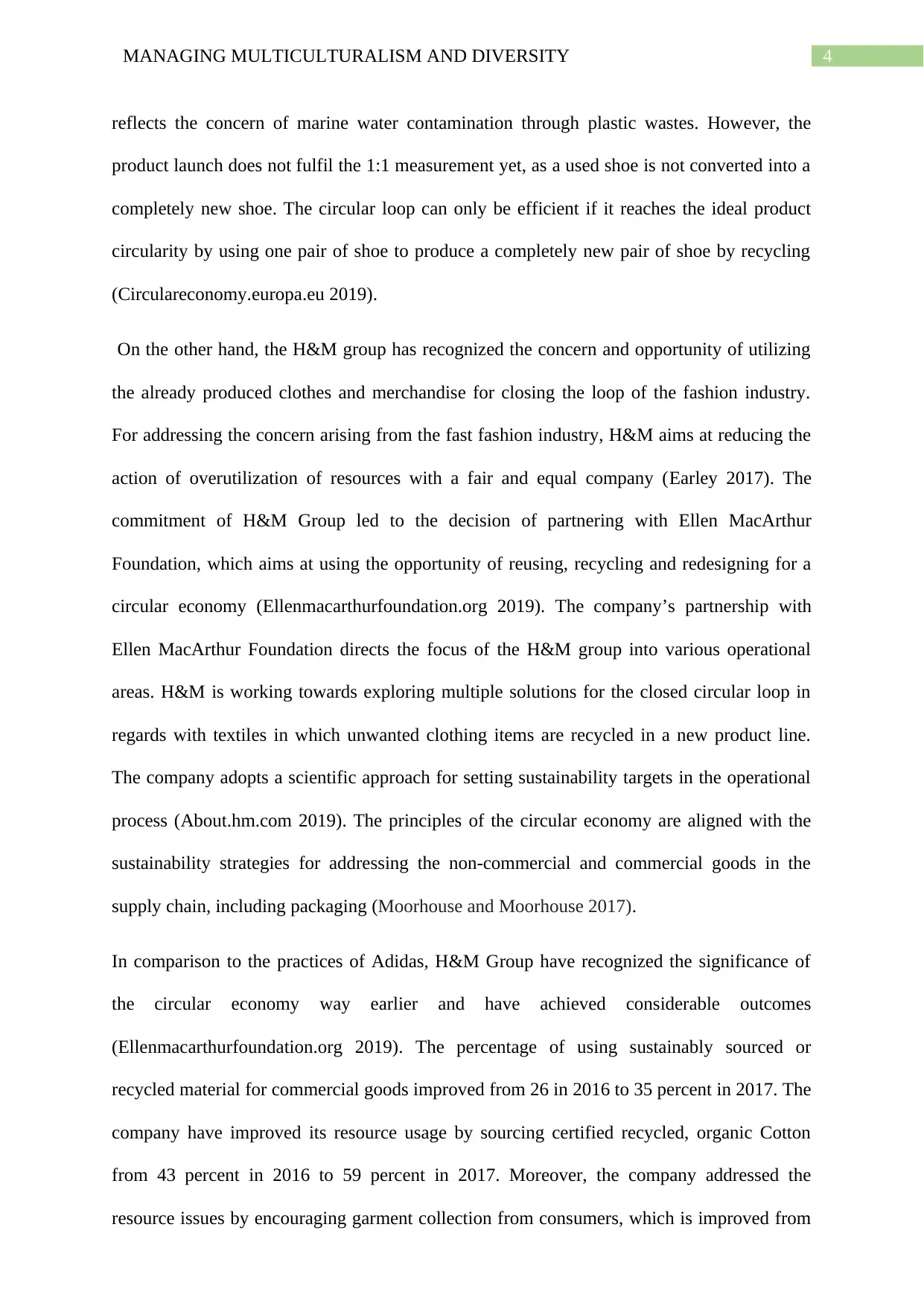
4MANAGING MULTICULTURALISM AND DIVERSITY
reflects the concern of marine water contamination through plastic wastes. However, the
product launch does not fulfil the 1:1 measurement yet, as a used shoe is not converted into a
completely new shoe. The circular loop can only be efficient if it reaches the ideal product
circularity by using one pair of shoe to produce a completely new pair of shoe by recycling
(Circulareconomy.europa.eu 2019).
On the other hand, the H&M group has recognized the concern and opportunity of utilizing
the already produced clothes and merchandise for closing the loop of the fashion industry.
For addressing the concern arising from the fast fashion industry, H&M aims at reducing the
action of overutilization of resources with a fair and equal company (Earley 2017). The
commitment of H&M Group led to the decision of partnering with Ellen MacArthur
Foundation, which aims at using the opportunity of reusing, recycling and redesigning for a
circular economy (Ellenmacarthurfoundation.org 2019). The company’s partnership with
Ellen MacArthur Foundation directs the focus of the H&M group into various operational
areas. H&M is working towards exploring multiple solutions for the closed circular loop in
regards with textiles in which unwanted clothing items are recycled in a new product line.
The company adopts a scientific approach for setting sustainability targets in the operational
process (About.hm.com 2019). The principles of the circular economy are aligned with the
sustainability strategies for addressing the non-commercial and commercial goods in the
supply chain, including packaging (Moorhouse and Moorhouse 2017).
In comparison to the practices of Adidas, H&M Group have recognized the significance of
the circular economy way earlier and have achieved considerable outcomes
(Ellenmacarthurfoundation.org 2019). The percentage of using sustainably sourced or
recycled material for commercial goods improved from 26 in 2016 to 35 percent in 2017. The
company have improved its resource usage by sourcing certified recycled, organic Cotton
from 43 percent in 2016 to 59 percent in 2017. Moreover, the company addressed the
resource issues by encouraging garment collection from consumers, which is improved from
reflects the concern of marine water contamination through plastic wastes. However, the
product launch does not fulfil the 1:1 measurement yet, as a used shoe is not converted into a
completely new shoe. The circular loop can only be efficient if it reaches the ideal product
circularity by using one pair of shoe to produce a completely new pair of shoe by recycling
(Circulareconomy.europa.eu 2019).
On the other hand, the H&M group has recognized the concern and opportunity of utilizing
the already produced clothes and merchandise for closing the loop of the fashion industry.
For addressing the concern arising from the fast fashion industry, H&M aims at reducing the
action of overutilization of resources with a fair and equal company (Earley 2017). The
commitment of H&M Group led to the decision of partnering with Ellen MacArthur
Foundation, which aims at using the opportunity of reusing, recycling and redesigning for a
circular economy (Ellenmacarthurfoundation.org 2019). The company’s partnership with
Ellen MacArthur Foundation directs the focus of the H&M group into various operational
areas. H&M is working towards exploring multiple solutions for the closed circular loop in
regards with textiles in which unwanted clothing items are recycled in a new product line.
The company adopts a scientific approach for setting sustainability targets in the operational
process (About.hm.com 2019). The principles of the circular economy are aligned with the
sustainability strategies for addressing the non-commercial and commercial goods in the
supply chain, including packaging (Moorhouse and Moorhouse 2017).
In comparison to the practices of Adidas, H&M Group have recognized the significance of
the circular economy way earlier and have achieved considerable outcomes
(Ellenmacarthurfoundation.org 2019). The percentage of using sustainably sourced or
recycled material for commercial goods improved from 26 in 2016 to 35 percent in 2017. The
company have improved its resource usage by sourcing certified recycled, organic Cotton
from 43 percent in 2016 to 59 percent in 2017. Moreover, the company addressed the
resource issues by encouraging garment collection from consumers, which is improved from
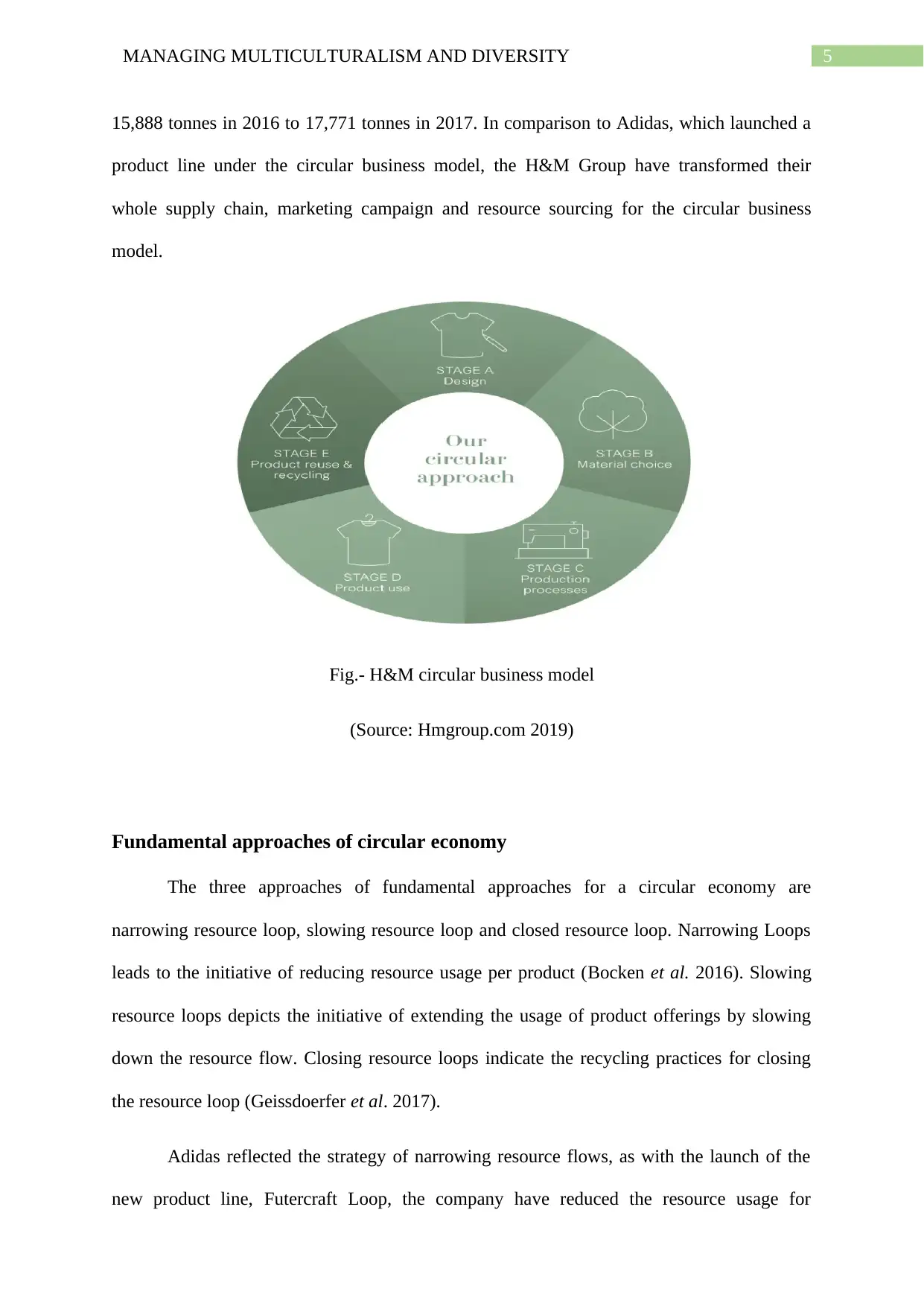
5MANAGING MULTICULTURALISM AND DIVERSITY
15,888 tonnes in 2016 to 17,771 tonnes in 2017. In comparison to Adidas, which launched a
product line under the circular business model, the H&M Group have transformed their
whole supply chain, marketing campaign and resource sourcing for the circular business
model.
Fig.- H&M circular business model
(Source: Hmgroup.com 2019)
Fundamental approaches of circular economy
The three approaches of fundamental approaches for a circular economy are
narrowing resource loop, slowing resource loop and closed resource loop. Narrowing Loops
leads to the initiative of reducing resource usage per product (Bocken et al. 2016). Slowing
resource loops depicts the initiative of extending the usage of product offerings by slowing
down the resource flow. Closing resource loops indicate the recycling practices for closing
the resource loop (Geissdoerfer et al. 2017).
Adidas reflected the strategy of narrowing resource flows, as with the launch of the
new product line, Futercraft Loop, the company have reduced the resource usage for
15,888 tonnes in 2016 to 17,771 tonnes in 2017. In comparison to Adidas, which launched a
product line under the circular business model, the H&M Group have transformed their
whole supply chain, marketing campaign and resource sourcing for the circular business
model.
Fig.- H&M circular business model
(Source: Hmgroup.com 2019)
Fundamental approaches of circular economy
The three approaches of fundamental approaches for a circular economy are
narrowing resource loop, slowing resource loop and closed resource loop. Narrowing Loops
leads to the initiative of reducing resource usage per product (Bocken et al. 2016). Slowing
resource loops depicts the initiative of extending the usage of product offerings by slowing
down the resource flow. Closing resource loops indicate the recycling practices for closing
the resource loop (Geissdoerfer et al. 2017).
Adidas reflected the strategy of narrowing resource flows, as with the launch of the
new product line, Futercraft Loop, the company have reduced the resource usage for
⊘ This is a preview!⊘
Do you want full access?
Subscribe today to unlock all pages.

Trusted by 1+ million students worldwide
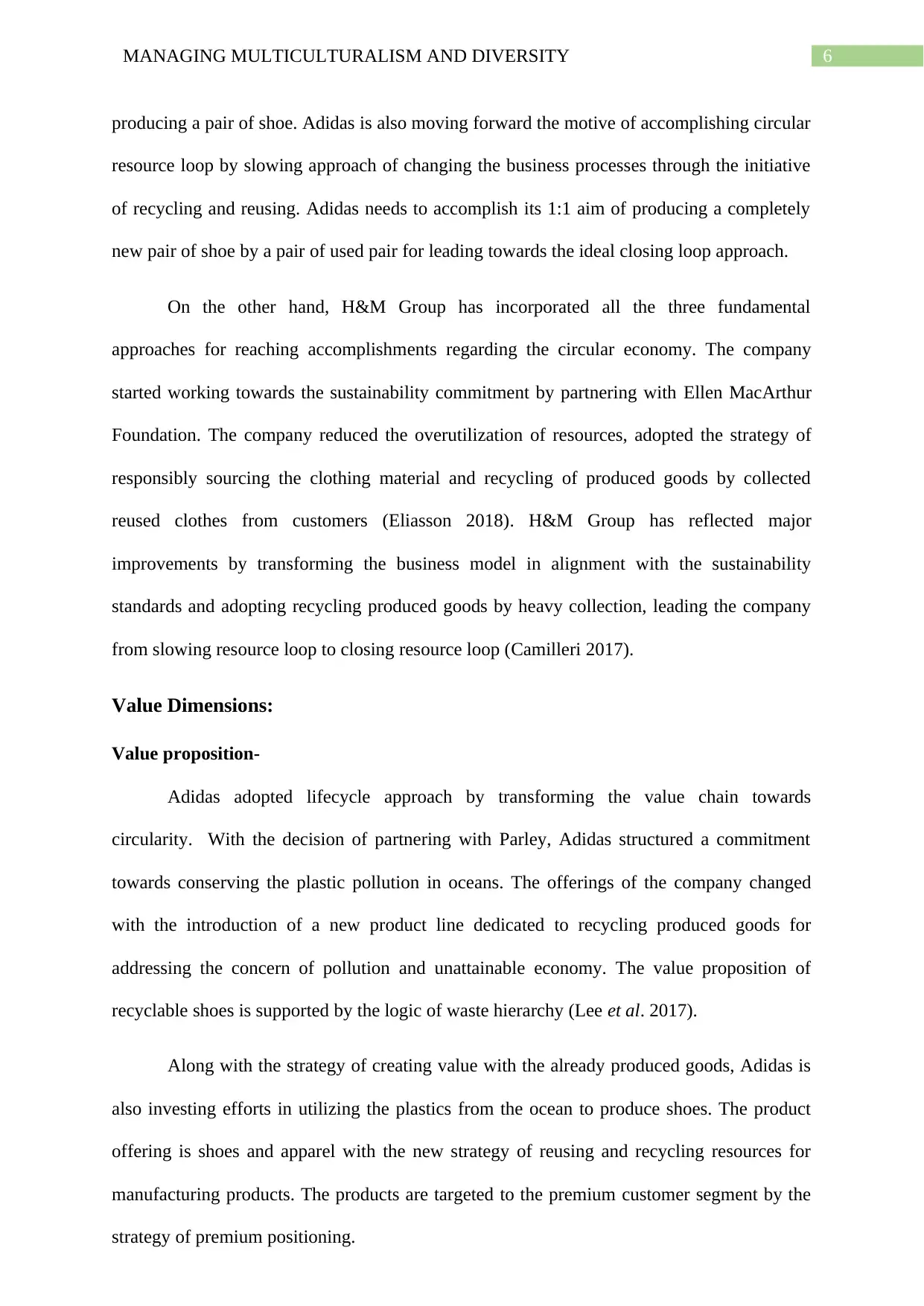
6MANAGING MULTICULTURALISM AND DIVERSITY
producing a pair of shoe. Adidas is also moving forward the motive of accomplishing circular
resource loop by slowing approach of changing the business processes through the initiative
of recycling and reusing. Adidas needs to accomplish its 1:1 aim of producing a completely
new pair of shoe by a pair of used pair for leading towards the ideal closing loop approach.
On the other hand, H&M Group has incorporated all the three fundamental
approaches for reaching accomplishments regarding the circular economy. The company
started working towards the sustainability commitment by partnering with Ellen MacArthur
Foundation. The company reduced the overutilization of resources, adopted the strategy of
responsibly sourcing the clothing material and recycling of produced goods by collected
reused clothes from customers (Eliasson 2018). H&M Group has reflected major
improvements by transforming the business model in alignment with the sustainability
standards and adopting recycling produced goods by heavy collection, leading the company
from slowing resource loop to closing resource loop (Camilleri 2017).
Value Dimensions:
Value proposition-
Adidas adopted lifecycle approach by transforming the value chain towards
circularity. With the decision of partnering with Parley, Adidas structured a commitment
towards conserving the plastic pollution in oceans. The offerings of the company changed
with the introduction of a new product line dedicated to recycling produced goods for
addressing the concern of pollution and unattainable economy. The value proposition of
recyclable shoes is supported by the logic of waste hierarchy (Lee et al. 2017).
Along with the strategy of creating value with the already produced goods, Adidas is
also investing efforts in utilizing the plastics from the ocean to produce shoes. The product
offering is shoes and apparel with the new strategy of reusing and recycling resources for
manufacturing products. The products are targeted to the premium customer segment by the
strategy of premium positioning.
producing a pair of shoe. Adidas is also moving forward the motive of accomplishing circular
resource loop by slowing approach of changing the business processes through the initiative
of recycling and reusing. Adidas needs to accomplish its 1:1 aim of producing a completely
new pair of shoe by a pair of used pair for leading towards the ideal closing loop approach.
On the other hand, H&M Group has incorporated all the three fundamental
approaches for reaching accomplishments regarding the circular economy. The company
started working towards the sustainability commitment by partnering with Ellen MacArthur
Foundation. The company reduced the overutilization of resources, adopted the strategy of
responsibly sourcing the clothing material and recycling of produced goods by collected
reused clothes from customers (Eliasson 2018). H&M Group has reflected major
improvements by transforming the business model in alignment with the sustainability
standards and adopting recycling produced goods by heavy collection, leading the company
from slowing resource loop to closing resource loop (Camilleri 2017).
Value Dimensions:
Value proposition-
Adidas adopted lifecycle approach by transforming the value chain towards
circularity. With the decision of partnering with Parley, Adidas structured a commitment
towards conserving the plastic pollution in oceans. The offerings of the company changed
with the introduction of a new product line dedicated to recycling produced goods for
addressing the concern of pollution and unattainable economy. The value proposition of
recyclable shoes is supported by the logic of waste hierarchy (Lee et al. 2017).
Along with the strategy of creating value with the already produced goods, Adidas is
also investing efforts in utilizing the plastics from the ocean to produce shoes. The product
offering is shoes and apparel with the new strategy of reusing and recycling resources for
manufacturing products. The products are targeted to the premium customer segment by the
strategy of premium positioning.
Paraphrase This Document
Need a fresh take? Get an instant paraphrase of this document with our AI Paraphraser
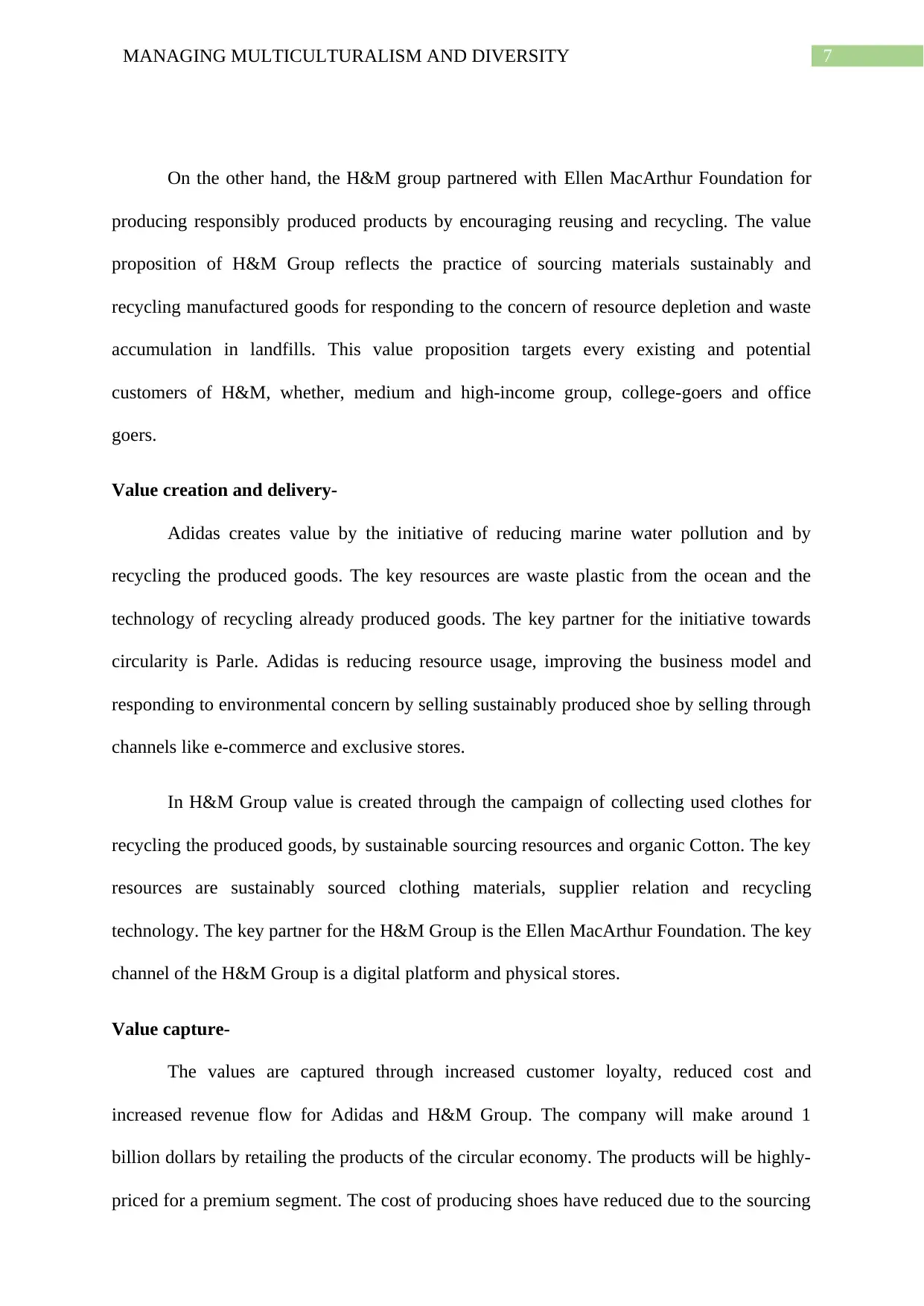
7MANAGING MULTICULTURALISM AND DIVERSITY
On the other hand, the H&M group partnered with Ellen MacArthur Foundation for
producing responsibly produced products by encouraging reusing and recycling. The value
proposition of H&M Group reflects the practice of sourcing materials sustainably and
recycling manufactured goods for responding to the concern of resource depletion and waste
accumulation in landfills. This value proposition targets every existing and potential
customers of H&M, whether, medium and high-income group, college-goers and office
goers.
Value creation and delivery-
Adidas creates value by the initiative of reducing marine water pollution and by
recycling the produced goods. The key resources are waste plastic from the ocean and the
technology of recycling already produced goods. The key partner for the initiative towards
circularity is Parle. Adidas is reducing resource usage, improving the business model and
responding to environmental concern by selling sustainably produced shoe by selling through
channels like e-commerce and exclusive stores.
In H&M Group value is created through the campaign of collecting used clothes for
recycling the produced goods, by sustainable sourcing resources and organic Cotton. The key
resources are sustainably sourced clothing materials, supplier relation and recycling
technology. The key partner for the H&M Group is the Ellen MacArthur Foundation. The key
channel of the H&M Group is a digital platform and physical stores.
Value capture-
The values are captured through increased customer loyalty, reduced cost and
increased revenue flow for Adidas and H&M Group. The company will make around 1
billion dollars by retailing the products of the circular economy. The products will be highly-
priced for a premium segment. The cost of producing shoes have reduced due to the sourcing
On the other hand, the H&M group partnered with Ellen MacArthur Foundation for
producing responsibly produced products by encouraging reusing and recycling. The value
proposition of H&M Group reflects the practice of sourcing materials sustainably and
recycling manufactured goods for responding to the concern of resource depletion and waste
accumulation in landfills. This value proposition targets every existing and potential
customers of H&M, whether, medium and high-income group, college-goers and office
goers.
Value creation and delivery-
Adidas creates value by the initiative of reducing marine water pollution and by
recycling the produced goods. The key resources are waste plastic from the ocean and the
technology of recycling already produced goods. The key partner for the initiative towards
circularity is Parle. Adidas is reducing resource usage, improving the business model and
responding to environmental concern by selling sustainably produced shoe by selling through
channels like e-commerce and exclusive stores.
In H&M Group value is created through the campaign of collecting used clothes for
recycling the produced goods, by sustainable sourcing resources and organic Cotton. The key
resources are sustainably sourced clothing materials, supplier relation and recycling
technology. The key partner for the H&M Group is the Ellen MacArthur Foundation. The key
channel of the H&M Group is a digital platform and physical stores.
Value capture-
The values are captured through increased customer loyalty, reduced cost and
increased revenue flow for Adidas and H&M Group. The company will make around 1
billion dollars by retailing the products of the circular economy. The products will be highly-
priced for a premium segment. The cost of producing shoes have reduced due to the sourcing
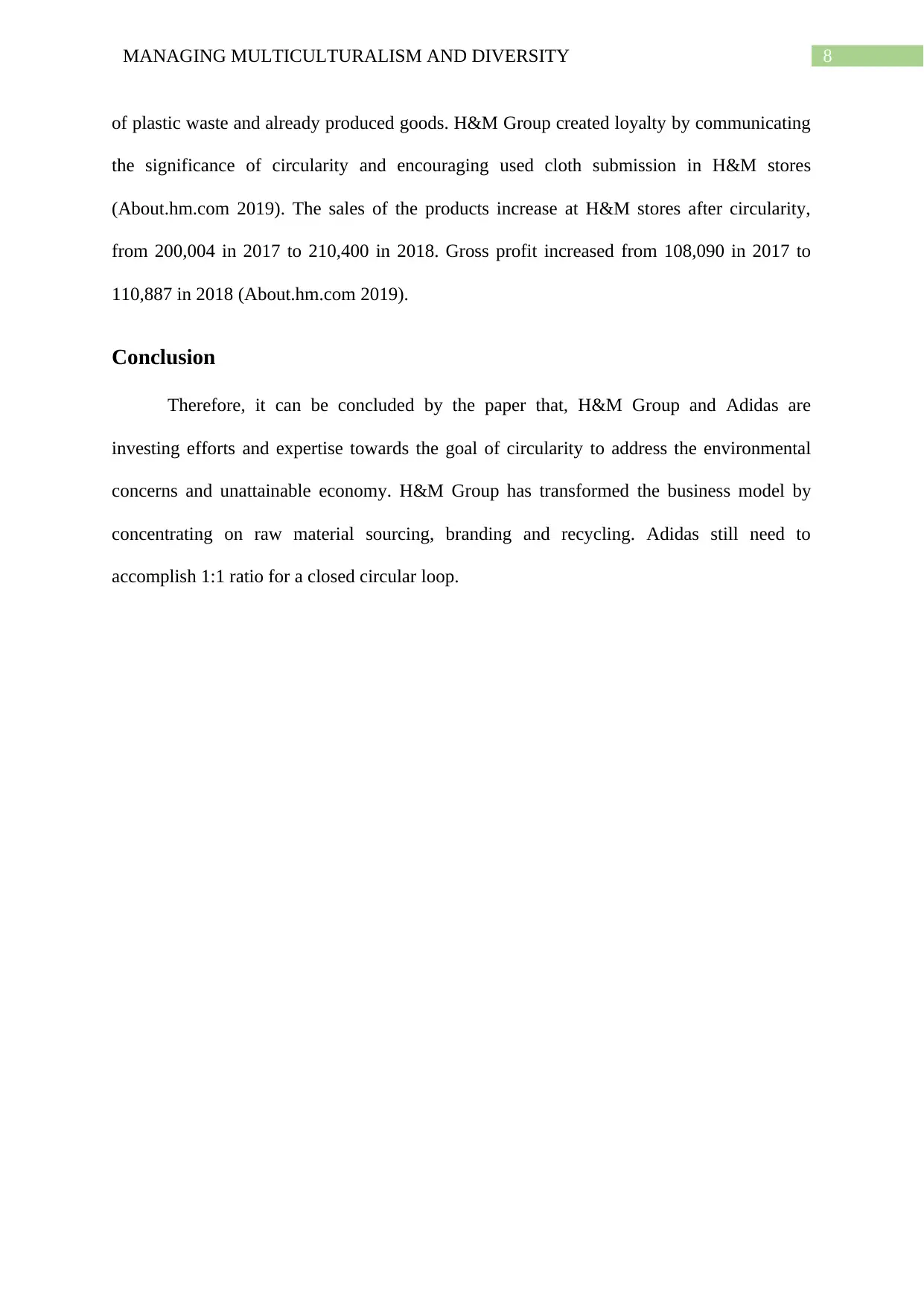
8MANAGING MULTICULTURALISM AND DIVERSITY
of plastic waste and already produced goods. H&M Group created loyalty by communicating
the significance of circularity and encouraging used cloth submission in H&M stores
(About.hm.com 2019). The sales of the products increase at H&M stores after circularity,
from 200,004 in 2017 to 210,400 in 2018. Gross profit increased from 108,090 in 2017 to
110,887 in 2018 (About.hm.com 2019).
Conclusion
Therefore, it can be concluded by the paper that, H&M Group and Adidas are
investing efforts and expertise towards the goal of circularity to address the environmental
concerns and unattainable economy. H&M Group has transformed the business model by
concentrating on raw material sourcing, branding and recycling. Adidas still need to
accomplish 1:1 ratio for a closed circular loop.
of plastic waste and already produced goods. H&M Group created loyalty by communicating
the significance of circularity and encouraging used cloth submission in H&M stores
(About.hm.com 2019). The sales of the products increase at H&M stores after circularity,
from 200,004 in 2017 to 210,400 in 2018. Gross profit increased from 108,090 in 2017 to
110,887 in 2018 (About.hm.com 2019).
Conclusion
Therefore, it can be concluded by the paper that, H&M Group and Adidas are
investing efforts and expertise towards the goal of circularity to address the environmental
concerns and unattainable economy. H&M Group has transformed the business model by
concentrating on raw material sourcing, branding and recycling. Adidas still need to
accomplish 1:1 ratio for a closed circular loop.
⊘ This is a preview!⊘
Do you want full access?
Subscribe today to unlock all pages.

Trusted by 1+ million students worldwide
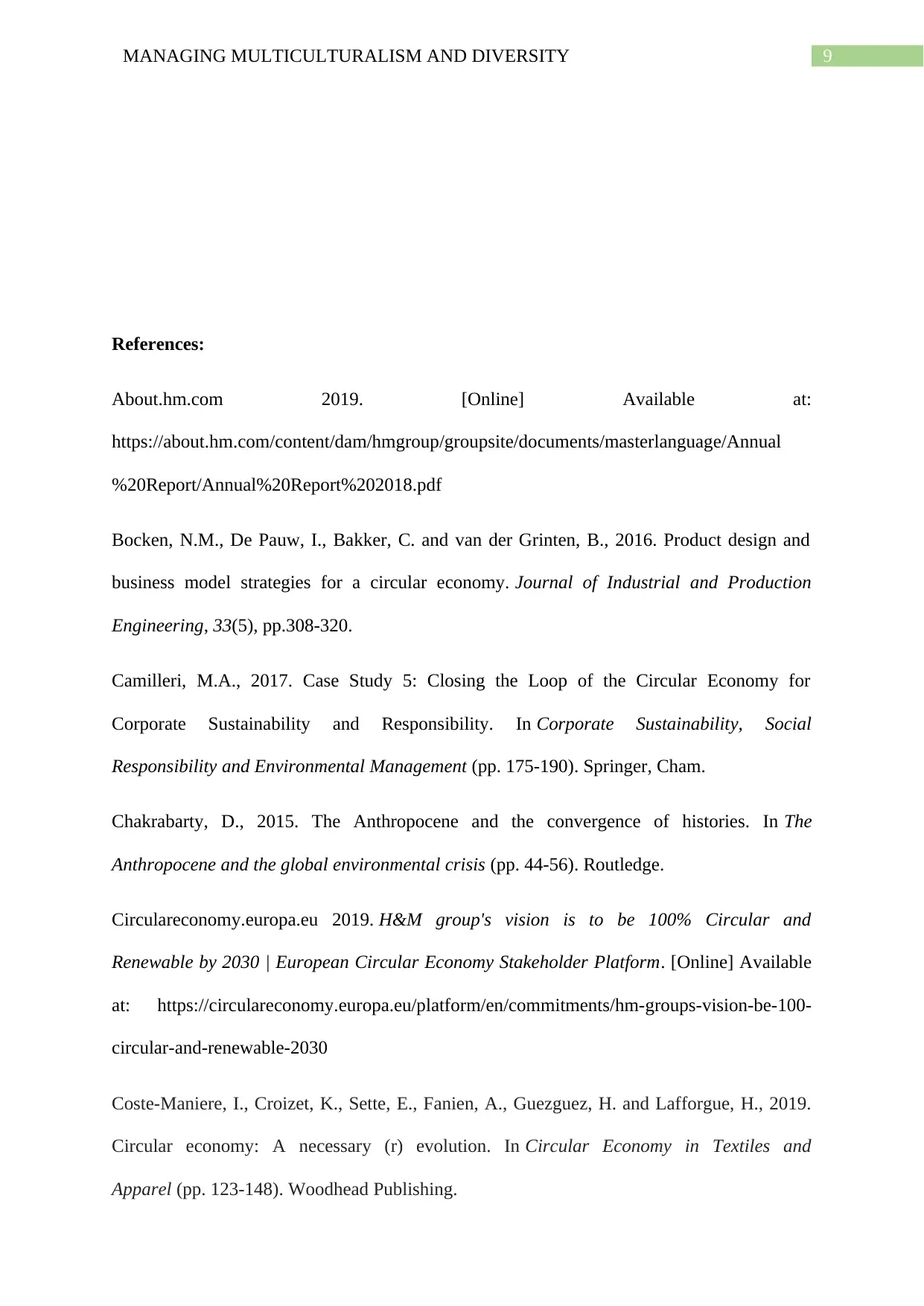
9MANAGING MULTICULTURALISM AND DIVERSITY
References:
About.hm.com 2019. [Online] Available at:
https://about.hm.com/content/dam/hmgroup/groupsite/documents/masterlanguage/Annual
%20Report/Annual%20Report%202018.pdf
Bocken, N.M., De Pauw, I., Bakker, C. and van der Grinten, B., 2016. Product design and
business model strategies for a circular economy. Journal of Industrial and Production
Engineering, 33(5), pp.308-320.
Camilleri, M.A., 2017. Case Study 5: Closing the Loop of the Circular Economy for
Corporate Sustainability and Responsibility. In Corporate Sustainability, Social
Responsibility and Environmental Management (pp. 175-190). Springer, Cham.
Chakrabarty, D., 2015. The Anthropocene and the convergence of histories. In The
Anthropocene and the global environmental crisis (pp. 44-56). Routledge.
Circulareconomy.europa.eu 2019. H&M group's vision is to be 100% Circular and
Renewable by 2030 | European Circular Economy Stakeholder Platform. [Online] Available
at: https://circulareconomy.europa.eu/platform/en/commitments/hm-groups-vision-be-100-
circular-and-renewable-2030
Coste-Maniere, I., Croizet, K., Sette, E., Fanien, A., Guezguez, H. and Lafforgue, H., 2019.
Circular economy: A necessary (r) evolution. In Circular Economy in Textiles and
Apparel (pp. 123-148). Woodhead Publishing.
References:
About.hm.com 2019. [Online] Available at:
https://about.hm.com/content/dam/hmgroup/groupsite/documents/masterlanguage/Annual
%20Report/Annual%20Report%202018.pdf
Bocken, N.M., De Pauw, I., Bakker, C. and van der Grinten, B., 2016. Product design and
business model strategies for a circular economy. Journal of Industrial and Production
Engineering, 33(5), pp.308-320.
Camilleri, M.A., 2017. Case Study 5: Closing the Loop of the Circular Economy for
Corporate Sustainability and Responsibility. In Corporate Sustainability, Social
Responsibility and Environmental Management (pp. 175-190). Springer, Cham.
Chakrabarty, D., 2015. The Anthropocene and the convergence of histories. In The
Anthropocene and the global environmental crisis (pp. 44-56). Routledge.
Circulareconomy.europa.eu 2019. H&M group's vision is to be 100% Circular and
Renewable by 2030 | European Circular Economy Stakeholder Platform. [Online] Available
at: https://circulareconomy.europa.eu/platform/en/commitments/hm-groups-vision-be-100-
circular-and-renewable-2030
Coste-Maniere, I., Croizet, K., Sette, E., Fanien, A., Guezguez, H. and Lafforgue, H., 2019.
Circular economy: A necessary (r) evolution. In Circular Economy in Textiles and
Apparel (pp. 123-148). Woodhead Publishing.
Paraphrase This Document
Need a fresh take? Get an instant paraphrase of this document with our AI Paraphraser
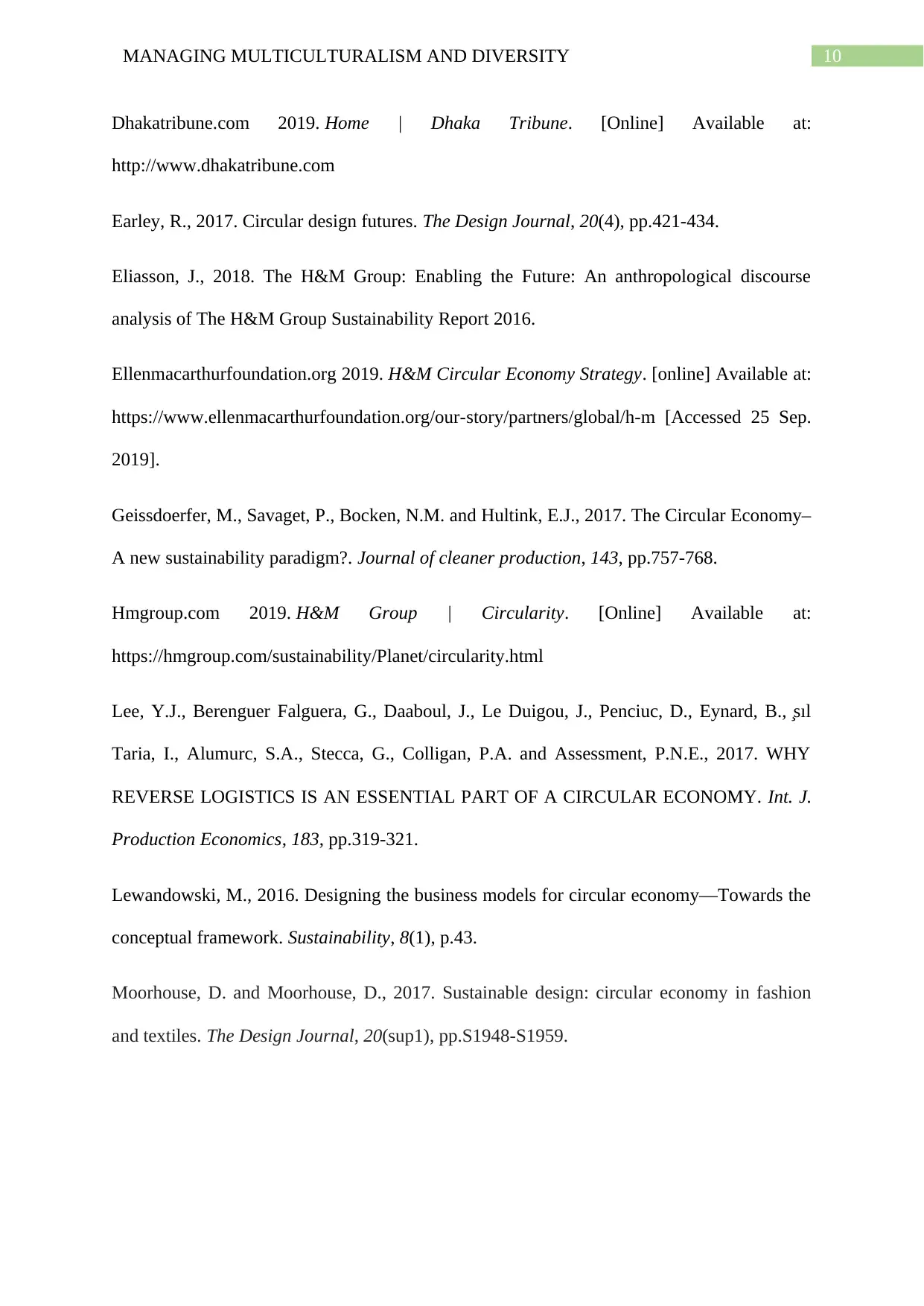
10MANAGING MULTICULTURALISM AND DIVERSITY
Dhakatribune.com 2019. Home | Dhaka Tribune. [Online] Available at:
http://www.dhakatribune.com
Earley, R., 2017. Circular design futures. The Design Journal, 20(4), pp.421-434.
Eliasson, J., 2018. The H&M Group: Enabling the Future: An anthropological discourse
analysis of The H&M Group Sustainability Report 2016.
Ellenmacarthurfoundation.org 2019. H&M Circular Economy Strategy. [online] Available at:
https://www.ellenmacarthurfoundation.org/our-story/partners/global/h-m [Accessed 25 Sep.
2019].
Geissdoerfer, M., Savaget, P., Bocken, N.M. and Hultink, E.J., 2017. The Circular Economy–
A new sustainability paradigm?. Journal of cleaner production, 143, pp.757-768.
Hmgroup.com 2019. H&M Group | Circularity. [Online] Available at:
https://hmgroup.com/sustainability/Planet/circularity.html
Lee, Y.J., Berenguer Falguera, G., Daaboul, J., Le Duigou, J., Penciuc, D., Eynard, B., ̧ sıl
Taria, I., Alumurc, S.A., Stecca, G., Colligan, P.A. and Assessment, P.N.E., 2017. WHY
REVERSE LOGISTICS IS AN ESSENTIAL PART OF A CIRCULAR ECONOMY. Int. J.
Production Economics, 183, pp.319-321.
Lewandowski, M., 2016. Designing the business models for circular economy—Towards the
conceptual framework. Sustainability, 8(1), p.43.
Moorhouse, D. and Moorhouse, D., 2017. Sustainable design: circular economy in fashion
and textiles. The Design Journal, 20(sup1), pp.S1948-S1959.
Dhakatribune.com 2019. Home | Dhaka Tribune. [Online] Available at:
http://www.dhakatribune.com
Earley, R., 2017. Circular design futures. The Design Journal, 20(4), pp.421-434.
Eliasson, J., 2018. The H&M Group: Enabling the Future: An anthropological discourse
analysis of The H&M Group Sustainability Report 2016.
Ellenmacarthurfoundation.org 2019. H&M Circular Economy Strategy. [online] Available at:
https://www.ellenmacarthurfoundation.org/our-story/partners/global/h-m [Accessed 25 Sep.
2019].
Geissdoerfer, M., Savaget, P., Bocken, N.M. and Hultink, E.J., 2017. The Circular Economy–
A new sustainability paradigm?. Journal of cleaner production, 143, pp.757-768.
Hmgroup.com 2019. H&M Group | Circularity. [Online] Available at:
https://hmgroup.com/sustainability/Planet/circularity.html
Lee, Y.J., Berenguer Falguera, G., Daaboul, J., Le Duigou, J., Penciuc, D., Eynard, B., ̧ sıl
Taria, I., Alumurc, S.A., Stecca, G., Colligan, P.A. and Assessment, P.N.E., 2017. WHY
REVERSE LOGISTICS IS AN ESSENTIAL PART OF A CIRCULAR ECONOMY. Int. J.
Production Economics, 183, pp.319-321.
Lewandowski, M., 2016. Designing the business models for circular economy—Towards the
conceptual framework. Sustainability, 8(1), p.43.
Moorhouse, D. and Moorhouse, D., 2017. Sustainable design: circular economy in fashion
and textiles. The Design Journal, 20(sup1), pp.S1948-S1959.
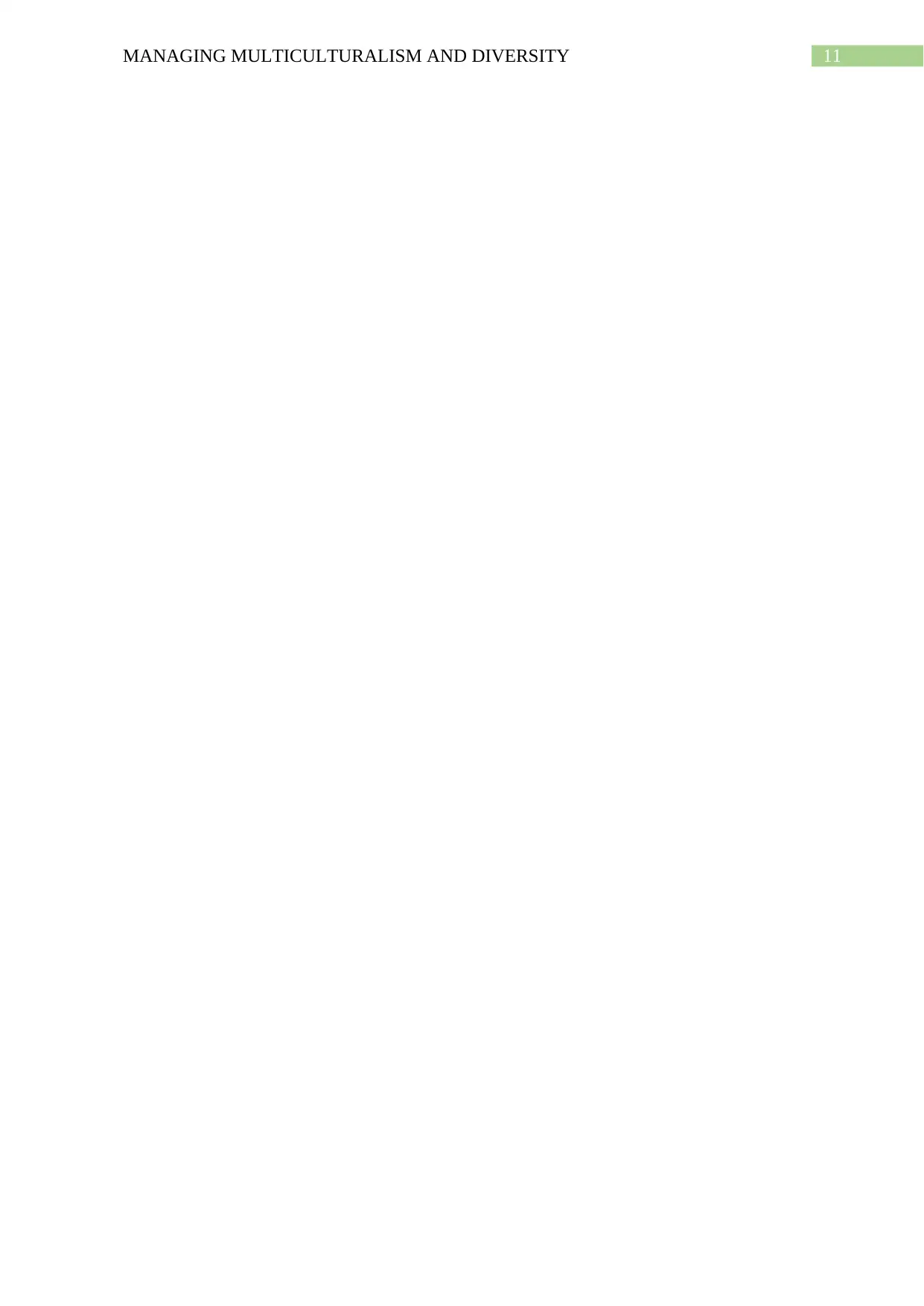
11MANAGING MULTICULTURALISM AND DIVERSITY
⊘ This is a preview!⊘
Do you want full access?
Subscribe today to unlock all pages.

Trusted by 1+ million students worldwide
1 out of 12
Related Documents
Your All-in-One AI-Powered Toolkit for Academic Success.
+13062052269
info@desklib.com
Available 24*7 on WhatsApp / Email
![[object Object]](/_next/static/media/star-bottom.7253800d.svg)
Unlock your academic potential
Copyright © 2020–2025 A2Z Services. All Rights Reserved. Developed and managed by ZUCOL.





